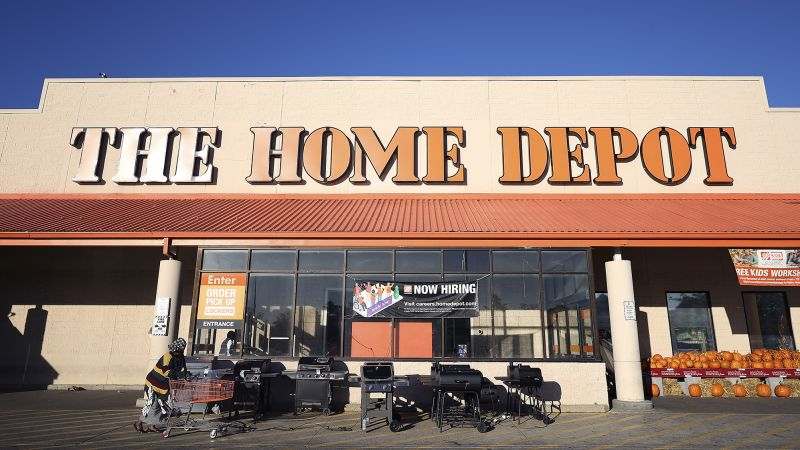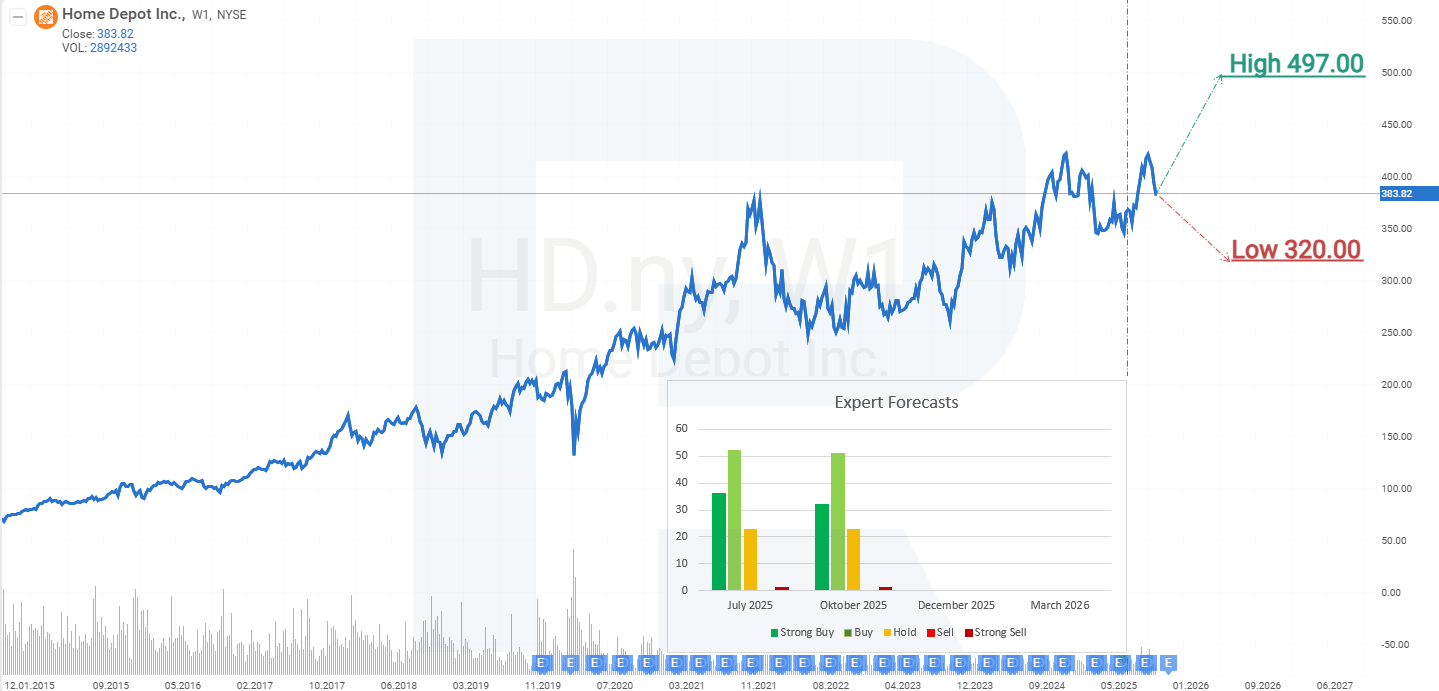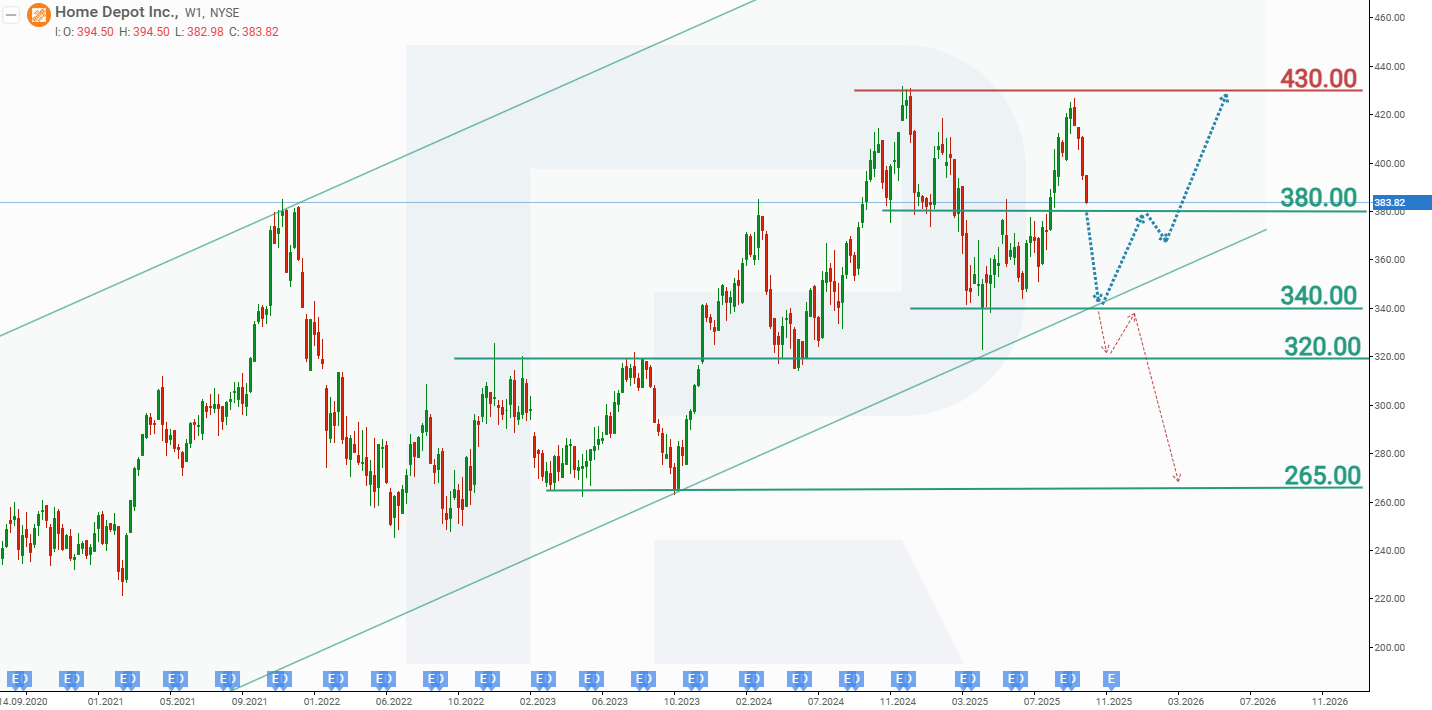Home Depot stock forecast for 2025: rising risks and falling share prices
Home Depot’s revenue and profit came in below analyst expectations, but investors are more concerned about the potential government shutdown and recent labour market data. As a result, HD shares have been losing ground.
In Q2 FY2025, The Home Depot, Inc. (NYSE: HD) generated 45.3 billion USD in revenue, up 4.9% year-on-year. Adjusted earnings per share (EPS) stood at 4.68 USD. Comparable sales increased 1.0%, including 1.4% growth in the US. Despite this growth, the figures fell slightly short of analyst expectations. The report noted a 0.4% decline in transaction volume, subdued demand for large-scale renovation projects, adverse currency effects, and slower sales of remaining inventories.
Management reaffirmed its full-year guidance, expecting revenue growth of around 2.8% and comparable sales to rise 1%. The company projects a gross margin of approximately 33.4% and an operating margin of 13% (adjusted – 13.4%). Annual interest expenses are estimated at roughly 2.2 billion USD, while diluted EPS is forecast to decline 3% from FY2024.
Despite the slight shortfall in revenue and EPS relative to expectations, investors reacted positively to the report. Home Depot confirmed its annual outlook, and management noted an acceleration in comparable sales in July. On this news, the stock rose by about 3%. The upward momentum continued until 17 September, when the share price reached a peak of 426 USD. The rally was supported by expectations of a Federal Reserve rate cut – and the actual 25-basis-point reduction to 4.00–4.25% – as well as a temporary easing of mortgage rates in September, which strengthened hopes for a rebound in housing-sector demand.
However, following the Fed’s rate cut, profit-taking began, and investors reassessed risks. The macroeconomic backdrop turned less favourable: August data showed a sharper-than-expected drop in new housing starts, and by October, mortgage rates were once again volatile. Further uncertainty arose from the US government shutdown, which began on 1 October, increasing risks to economic data and consumer activity. As a result, the stock reversed its gains, falling to around 384 USD by 9 October.
This article examines The Home Depot, Inc., outlines its key revenue sources, reviews the company’s performance for Q1 FY2025, and presents expectations for Q2 FY2025. It also includes a technical analysis of HD shares, which forms the basis for a Home Depot stock forecast for calendar 2025.
About The Home Depot, Inc.
The Home Depot, Inc. is the largest home improvement and construction retail chain in the US. The company was founded in 1978 by entrepreneurs Bernard Marcus, Arthur Blank, Ron Brill, and Pat Farrah in Atlanta, Georgia. Home Depot went public in 1981, listing on the New York Stock Exchange under the ticker HD.
Its core business involves the sale of building materials, tools, renovation supplies, gardening products, and home improvement goods, as well as related services for both private and commercial customers.
Key competitors include Lowe’s, Walmart (NYSE: WMT), Menards, and online retailer Amazon in the home improvement and DIY categories.
Image of the company name The Home Depot, Inc.The Home Depot, Inc.’s main financial streams
Home Depot’s business model is built around the sale of products and services related to home improvement, construction, and renovation. The company’s revenue is generated from the following key components:
- Retail product sales : This segment is the company’s primary source of revenue, encompassing the sale of building materials, tools, plumbing supplies, lighting fixtures, flooring, furniture, appliances, and gardening equipment
- E-commerce : Home Depot continues to expand its online presence. Revenue is generated through direct online orders as well as ‘buy online, pick up in store’ (BOPIS) and home delivery models
- Installation and repair services : The company offers paid services, including kitchen, flooring, door and window installation, appliance setup, and home repairs
- Professional customer (Pro Business) sales : A significant portion of revenue comes from Pro customers – building contractors, tradespeople, and organisations that regularly purchase large volumes of materials and tools
- Financial and related services : Additional income is generated through financing solutions, gift cards, loyalty programs, equipment rentals, and value-added services designed to support home improvement and construction projects
Home Depot’s business model combines mass retail with tailored services for both DIY consumers and professionals, leveraging a broad product range, in-store services, and digital channels to drive sustainable revenue growth.
The Home Depot, Inc. Q1 FY2025 report
On 20 May, Home Depot released its Q1 FY2025 financial results, which ended on 4 May. The key figures compared with the same period last year are as follows:
- Revenue : 39.86 billion USD (+9%)
- Net profit : 3.43 billion USD (-32%)
- Earnings per share : 3.56 USD (-30%)
- Operating margin : 13.2% (-90 basis points)
Home Depot’s Q1 FY2025 report showed continued revenue growth of 9.4% year-on-year, reaching 39.9 billion USD, slightly ahead of analysts’ expectations. This performance reflects stable customer activity (nearly 395 million transactions), even as the average transaction value remained flat. Comparable sales declined by 0.3% overall due to currency fluctuations; however, a 0.2% increase in the US highlights the resilience of its core domestic market. Adjusted earnings per share came in at 3.56 USD, slightly below expectations, breaking a multi-quarter run of upside surprises – although the miss was marginal.
During the earnings call, management emphasised a measured and strategic approach. Despite the introduction of new tariffs, Home Depot chose not to pass additional costs on to consumers by raising prices across a broad range of products. This was made possible by its diversified supply chain, with approximately half of its inventory sourced domestically and no single foreign country accounting for more than 10%. As a result, the company opted to absorb the additional expenses itself, helping to preserve its competitive positioning – in contrast to competitors such as Walmart, which has signalled plans to increase prices for consumers.
The company reaffirmed its full-year guidance, forecasting revenue growth of approximately 2.8%, comparable sales growth of around 1%, and a decline in adjusted EPS of roughly 2%. The outlook for Q2 was also described as stable, although management pointed to ongoing pressure from elevated interest rates, which continue to weigh on demand for larger-scale projects.
For investors, the past quarter offered several encouraging signals: revenue growth was driven by smaller projects, pricing discipline remains intact, market share appears well-protected, and full-year targets were reaffirmed. Yes, the drop in EPS and macroeconomic risks, such as a strong US dollar and cautious consumer sentiment, suggest a more moderate near-term trajectory. Even so, the Q2 guidance supports confidence in the outlook, backed by modest sales growth expectations and steady performance in the US. Overall, for those seeking a defensive position in the consumer sector with strong margins and robust pricing discipline, Home Depot shares are an attractive option.
The Home Depot, Inc. Q2 FY2025 report
On 29 August, Home Depot released its results for Q2 FY2025, covering the period ended 3 August. The key financial indicators compared with the same period of the previous year were as follows:
- Revenue : 45.28 billion USD (+4.9%)
- Net profit (non-GAAP) : 4.65 billion USD (+0.4%)
- Earnings per share (EPS) : 4.68 USD (+0.2%)
- Operating margin : 14.8% (–50 basis points)
Home Depot reported year-on-year revenue growth of 5% to 45.3 billion USD, while adjusted earnings per share came in at 4.68 USD, slightly below analyst expectations. The average ticket size increased, though in-store traffic edged down slightly. Strong sales were recorded in high-value purchases over 1,000 USD, cordless power tools, home appliances, and storage products. Online sales grew 12%, and both professional and retail customers increased their spending.
Challenges included subdued demand for large-scale renovation projects, slower inventory turnover, and some pressure from exchange-rate movements. Despite these headwinds, the company continues to invest in business development and shareholder returns, allocating around 3.2 billion USD to dividends and capital expenditure during the quarter. Return on invested capital for the year declined from 31.9% to 27.2%.
Management reaffirmed its full-year outlook, expecting sales growth of 2.8% and stable profitability, though earnings per share are expected to be around 2% lower than in FY2024.
Fundamental analysis of The Home Depot, Inc.
Below is the fundamental analysis of HD following the Q2 FY2025 results:
- Liquidity and debt : at the end of Q2 FY2025, Home Depot held nearly 2.8 billion USD in cash. Total current assets stood at 35.4 billion USD, compared with current liabilities of 30.9 billion USD – indicating that the company has sufficient resources to cover its short-term obligations.
Total debt amounted to 52.3 billion USD, of which 6.4 billion USD is due within the next year. Net debt stood at 49.5 billion USD. Interest expenses were 575 million USD for the quarter, which Home Depot can comfortably cover from its earnings. The company also has access to 11 billion USD in unused revolving credit facilities and commercial paper programs, which remain undrawn
- Cash flow and free cash : in the first half of FY2025, Home Depot generated 8.97 billion USD in operating cash flow (down from 10.91 billion USD a year earlier). The decline was mainly due to temporary changes in working capital. Capital expenditure (CapEx) totalled 1.72 billion USD, resulting in free cash flow of 7.25 billion USD. From this amount, the company paid 4.57 billion USD in dividends, fully covered by operating cash flow. Share buybacks remain paused, though the company retains 11.7 billion USD in authorised capacity for future repurchases
- Profitability and earnings quality : in Q2 FY2025, revenue reached 45.28 billion USD, up 4.9% year-on-year. Operating margin was 14.5% under GAAP and 14.8% on a non-GAAP basis. Adjusted EPS increased by 0.2% to 4.68 USD. Cash flow for the half-year exceeded net profit, indicating strong earnings quality – meaning profits are supported by robust cash generation rather than accounting adjustments
- Balance sheet resilience : inventories were valued at 25 billion USD – a modest increase, supported by stable sales. Accounts payable stood at 13.1 billion USD. Shareholders’ equity totalled 10.67 billion USD, relatively low compared with debt, as Home Depot has historically used leverage for major transactions and share buybacks. Nevertheless, the company remains financially stable: it maintains high margins, a strong return on invested capital (ROIC) of 27.2%, and solid access to financing
Conclusion of the fundamental analysis of HD:
Home Depot’s financial position remains strong. The company easily covers its interest expenses, generates substantial free cash flow, and funds dividends entirely from its own operations. It also retains access to standby credit lines and borrowing capacity. On the weaker side, liquidity – excluding inventories –
is somewhat limited, while inventory levels are rising and overall debt remains elevated due to past large-scale buybacks and acquisitions. However, these risks are well contained thanks to stable profitability and predictable sales. The company maintained its full-year outlook, expecting a slight decline in earnings per share, but should continue paying dividends and may resume share repurchases once leverage is reduced.
Expert forecasts for The Home Depot, Inc. stock
- Barchart : 25 of 35 analysts rated Home Depot shares as Strong Buy, 1 as Moderate Buy, 8 as Hold, and 1 as Strong Sell. The upper-end forecast is 497 USD, with the lower-end forecast at 320 USD
- MarketBeat : 20 of 26 analysts assigned a Buy rating, and 6 recommended Hold. The upper-end forecast is 497 USD, with the lower-end forecast at 360 USD
- TipRanks : 19 of 25 analysts rated the stock as Buy, and 6 as Hold. The upper-end forecast is 497 USD, with the lower-end forecast at 400 USD
- Stock Analysis : 7 of 21 experts rated Home Depot shares as Strong Buy, 11 as Buy, and 3 as Hold. The upper-end forecast is 497 USD, with the lower-end forecast at 398 USD
The Home Depot, Inc. stock price forecast for 2025
The publication of the quarterly report helped the stock climb to a new all-time high. However, following the Federal Reserve’s interest rate cut, investors opted to lock in profits rather than hold Home Depot shares in their portfolios, triggering a price decline. Weak labour market data added further pressure, and nearly all the gains achieved after the report were erased. Based on the current performance of Home Depot shares, two possible scenarios for HD’s movement in 2025 can be outlined as follows:
Base case forecast for Home Depot stock: this scenario assumes a decline in HD’s share price towards support at around 340 USD. A rebound from this level could act as a catalyst for a recovery towards the all-time high near 430 USD. This outlook takes into account the ongoing US government shutdown, which is weighing on the stock, but its resolution could restore market optimism and enable the shares to resume their upward trend towards record levels.
Alternative forecast for Home Depot shares: this scenario assumes a break below the 340 USD support level. In that case, the share price could fall towards 265 USD. This outcome would become more likely if the government shutdown were to persist and labour market data proved significantly weaker than expected, which could negatively affect sales volumes. An additional risk is rising inflation, which may further erode consumers’ purchasing power.
The Home Depot, Inc. stock analysis and forecast for 2025Risks of investing in The Home Depot, Inc. stock
Investing in Home Depot stock involves a range of external and internal risk factors that could negatively impact the company’s revenue and financial performance. The key risks include:
- Dependence on broader economic conditions and the housing market : Demand for home improvement and construction products is closely linked to macroeconomic factors, mortgage interest rates, and housing market activity. A recession, rising interest rates, or a slowdown in residential construction could result in reduced sales
- Volatility in raw material prices and logistics costs : Increases in the cost of lumber, metals, oil, or transportation may drive up input costs, potentially squeezing margins or dampening consumer demand
- Competitive and pricing pressures : Home Depot faces intense competition from Lowe’s, Menards, Amazon, and other retailers. Greater pricing pressure or a loss of market share could weigh on revenue and profitability
- Exposure to the professional customer segment (Pro) : The Pro segment accounts for a significant share of revenue. A slowdown in construction activity or a decline in demand from contractors could affect the company’s financial results
- Changes in consumer behaviour : A decline in interest in DIY projects, particularly among younger demographics, or a shift towards online channels dominated by other players could challenge Home Depot’s traditional retail model
- Regulatory and labour-related risks : Stricter labour regulations, higher minimum wages, or recruitment and retention difficulties could increase operating costs and compromise service quality
These risks should be considered when assessing Home Depot’s business model resilience and the long-term outlook for its shares.
Forecasts presented in this section only reflect the author’s private opinion and should not be considered as guidance for trading. RoboForex bears no responsibility for trading results based on trading recommendations described in these analytical reviews.




